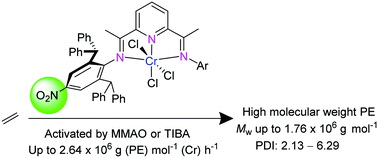Achievement of strictly linear ultra-high molecular weight polyethylene with narrow dispersity by dint of nitro-enhanced 2,6-bis(imino)pyridylchromium chloride complexes†
Abstract
Herein, chromium(III) complexes bearing unsymmetrical 2-[1-(2,6-dibenzhydryl-4-nitrophenylimino)ethyl]-6-[1-(arylimino)ethyl]-pyridine (aryl = 2,6-Me2Ph (Cr1), 2,6-Et2Ph (Cr2), 2,6-iPr2Ph (Cr3), 2,4,6-Me3Ph (Cr4), and 2,6-Et2-4-MePh (Cr5)) and the symmetrical complex 2,6-bis(1-(2,6-dibenzhydryl-4-nitrophenylimino)ethyl)pyridylchromium chlorides (Cr6) were prepared and validated via FTIR spectroscopy and elemental analysis. Solid-state structures of the complexes Cr3 and Cr6 were established by single-crystal X-ray diffraction, highlighting a distorted octahedral geometry around the chromium center. Upon activation with modified methylaluminoxane (MMAO) or triisobutylaluminium (TIBA), most of these chromium pre-catalysts exhibited high activities towards ethylene polymerization, producing strictly linear polyethylene with high molecular weights and narrow distributions (PDI: 2.13–6.29). When TIBA was used as a co-catalyst, the molecular weight of the synthesized polyethylene was up to 1.76 × 106 g mol−1; moreover, this polyethylene showed some typical features of ultra-high molecular weight polyethylene (UHMWPE).



 Please wait while we load your content...
Please wait while we load your content...